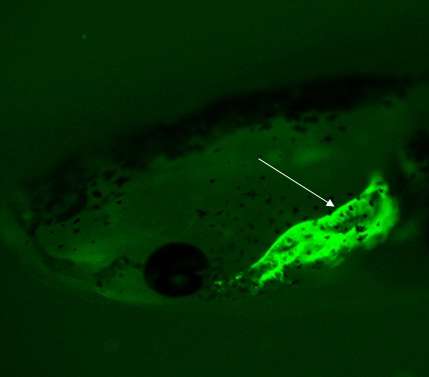Fluorescence visualization of a gill in a frog embryo using the PITCh knock-in system. The arrow indicates the gill (Green). Credit: Department of Mathematical and Life Sciences, Graduate School of Science, Hiroshima University
Using a novel gene knock-in technique, effective insertion of an exogenous gene was demonstrated in human cells and in animal models, including silkworms and frogs. This strategy universally enables gene knock-in not only in cultured cells, but also in various organisms.
Genome editing using programmable nucleases enables homologous recombination (HR)-mediated gene knock-in. HR activity, however, is relatively low in most cultured cells and organisms. This problem presents technical hurdles for the application of HR-mediated knock-in technology in the field of life sciences.
Professor Takashi Yamamoto and his colleagues, Dr. Ken-ichi T. Suzuki and Dr. Tetsushi Sakuma, at the Graduate School of Science at Hiroshima University, Professor Masanobu Obara at the Graduate School of Science at Hiroshima University, and Professor Hideki Sezutsu at the National Institute of Agrobiological Sciences have introduced an innovative strategy for gene knock-in using transcription activator-like effector nucleases (TALENs) and clustered regularly interspaced short palindromic repeats (CRISPR)/CRISPR-associated 9 (Cas9)-mediated by microhomology-mediated end-joining, termed the PITCh (Precise Integration into Target Chromosome) system. TALEN-mediated PITCh enables efficient integration of exogenous donor DNA into target sites on chromosomes in human cells, silkworms, and frogs. The research group further demonstrated that CRISPR/Cas9-mediated PITCh could be applied in human cells without carrying the plasmid backbone sequence.
These results were published in Nature Communications in an article entitled "Microhomology-mediated end-joining-dependent integration of donor DNA in cells and animals using TALENs and CRISPR/Cas9."
The PITCh system will be useful for a variety of applications, including creation of disease-modeling cells and animals for drug screening and therapy development. Additionally, it is expected that this knock-in technique will increase the production efficiency of useful recombinant proteins such as pharmaceutical materials in cultured animal cells. Furthermore, in silkworms, these strategies can be applied to production of functional recombinant silk proteins. The research group anticipates that the PITCh system will enhance the usefulness of genome editing techniques in a variety of cells and organisms, especially in those in which gene knock-in is hindered by low HR efficiency.
Journal information: Nature Communications
Provided by Hiroshima University






















